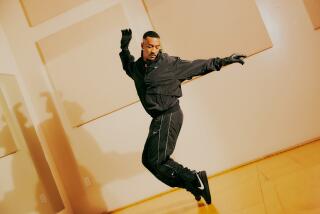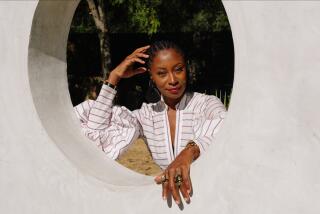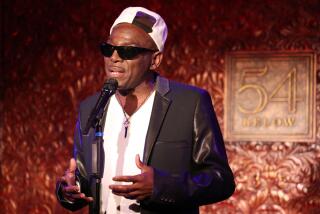Bella Lewitzky’s former dancers build her legacy
We all know what happens when great composers, writers and artists die: Their work lives on. But what about groundbreaking choreographers — say, Martha Graham, José Limon, Merce Cunningham, Antony Tudor, Alvin Ailey, George Balanchine — those creators whose inspiration floats on a flashing moment, an instant image, a looming structure, perhaps never to be recaptured?
A question of survival follows. Because, unlike music (written in scores), art (hanging on museum walls) and books (housed in libraries), dance is lost without person-to-person transmission from the designate to the next-generation dancer who is learning a part.
Fortunately, though, there are keepers of the flame who can pass on those masterworks. John Pennington and British-born Yolande Yorke-Edgell are such guardians. Alums of the Bella Lewitzky Dance Company, they’ve staged a number of the modern dance choreographer’s classics and are joining to present “Across Connections,” an homage to their beloved mentor.
“You cannot fill a dance with color and texture or bring it back to life unless there’s someone there who’s reflecting you and knows your energy,” explains Pennington, 51. “Dance notation and videotapes are only tools.”
So what he passes along to his dancers when resurrecting her pieces is exactly that breath-to-breath, hands-on coaching that Lewitzky herself imparted to him.
And it’s the same with Yorke-Edgell, who at 43 says, “Bella’s body movement was so detailed that everything changed when she coached me.... It wasn’t just about dancing anymore but about spatial design with a purpose.”
That wasn’t all, though. Lewitzky, who died in 2004 at age 88, wielded a powerful artistic influence in Los Angeles dance for 50 years, winning international recognition as well. She became a moral compass for her company members and for fellow defenders of civil liberties. She was the articulate soothsayer who stood up to the House Committee on Un-American Activities in the 1950s and instead of naming names told the panel, “I’m a dancer, not a singer.”
Pennington, Yorke-Edgell and all those who witnessed her social conscience in action understood that Lewitzky was not content just to nurture the muse. After all, when she boldly rejected a $72,000 grant from the National Endowment for the Arts rather than sign an anti-obscenity oath, company members did without their paychecks — until she won her case against the federal government and the grant could be reinstated. She also went on to be decorated with the National Medal of Arts and the Bill of Rights Award from the American Civil Liberties Union.
It’s hardly surprising, then, that Lewitzky’s ethos has inspired former company members to civic awareness and creative heights.
“What I had with her,” says Pennington, who performed with the Lewitzky troupe for 14 years until it folded in 1997, “was an apprenticeship in life and dance. She molded my artistic values.
“In the end I didn’t care whether I forfeited an income during the civil rights case because learning what integrity meant put everything in perspective for me. Lewitzky taught us how to dream and imagine but also that art did not exist in a vacuum.”
‘Architecture in space’
It’s a sunny afternoon at his Pasadena studio-performance space and dancers of the Pennington Dance Group go through their rehearsal paces as the choreographer claps counts.
He stops them for a moment: “Think about your architecture in space,” he says as they grope their way through the steps and the accents. “Know that space, put your bodies into it.”
The piece is “Overlay,” one of three works on the bill. It stands as his collaborative effort with Yorke-Edgell and her London-based troupe. “And, yes, it has a message,” says the trim Pennington. “It’s the idea of sharing a space, of a first date, maybe, of how people, meeting each other, can experience the most hopeful feelings, along with the inevitable discomfort. It’s all about interaction. And if successful, it will stir a kinesthetic empathy from the audience.”
As a Lewitzky dancer, he cut a figure of crystalline form and focus, quicksilver like his guru. Now he coaxes the same from his performers, jumping in to demonstrate. And although the dance springs solely from his choreographic imagination, we can see some of the spatial elements that defined a Lewitzky piece — a geometric pattern filled with multi-rhythmic, multi-relational impulses, the dancers watching each other, then competing, embracing, disengaging, clinging.
“Bella called herself a ‘cool modernist,’” Pennington says, leaning back on a lobby couch after rehearsal. “She worked in abstract design, a complete departure from theatrical narrative,” and from the post-modern grab-bag collages that permeate today’s stages, he adds. “But that’s not to say her dances were without emotional content. Narrative came out of the movement.”
“And when I reconstructed Bella’s ‘Recuerdo’ and ‘Metaphor,’” says Yorke-Edgell, who began her Yorke Dance Project in 1998 after dancing with Lewitzky from 1994 and is remembered here as a gorgeously supple, articulate performer, “the London audiences went wild. That kind of work, with all its clarity and perfection, had the impact of a great Graham or Cunningham piece. What we commonly get in the U.K. is either dance theater or physical theater or ballet dancers doing modern.
“But traditional, high-skilled technique has been out the window. Maybe it’s headed for a comeback, although untrained bodies can’t do it.”
Pennington underscores that observation when he speaks of “how Bella’s ethic was about building the body to perfection, and inside of that, the freedom one gets. It took me eight years to get it fully ingrained.”
Lewitzky let him stand in for her as company teacher on the road and later even gave him her solo “On the Brink of Time,” which he still performs. But she didn’t want her company to become a mausoleum. And so in that spirit Pennington and Yorke-Edgell have carried out what they think she would approve: Two choreographers forging their paths and, as legatees, occasionally mounting one of her works.
Thanks to them, “On the Brink of Time” is always in the present.
More to Read
The biggest entertainment stories
Get our big stories about Hollywood, film, television, music, arts, culture and more right in your inbox as soon as they publish.
You may occasionally receive promotional content from the Los Angeles Times.





